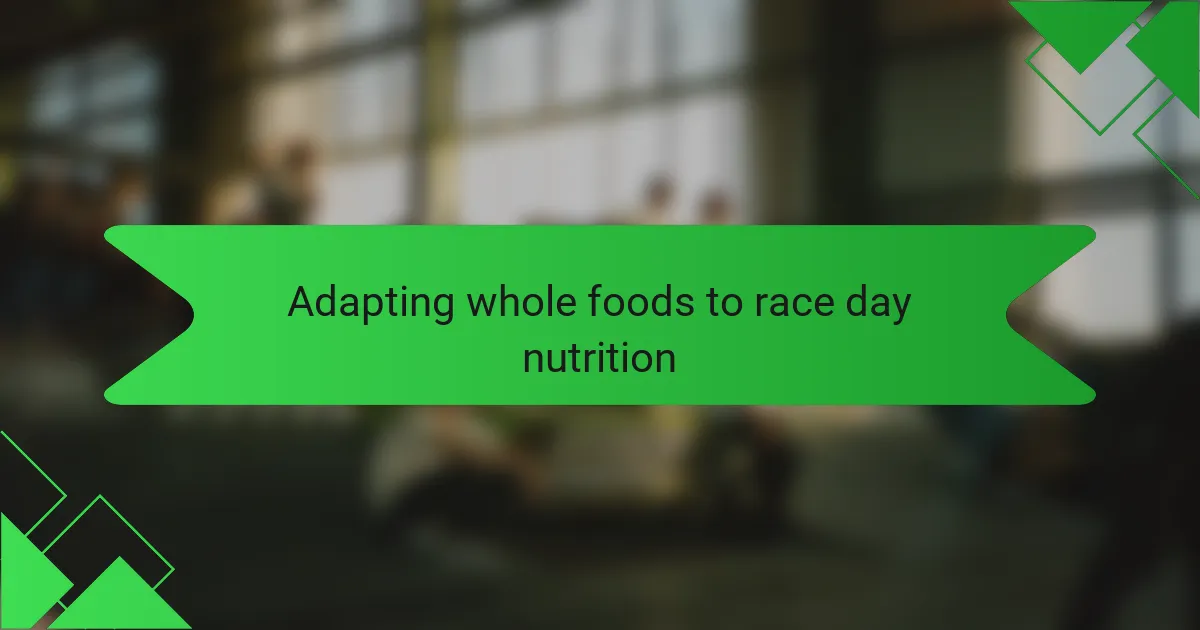Key takeaways
- Whole foods offer sustained energy, improve recovery, and reduce inflammation compared to processed foods.
- Key nutrients like complex carbohydrates, lean proteins, and healthy fats are essential for endurance and muscle repair in obstacle racing.
- Meal planning with whole foods enhances performance by ensuring balanced meals that support digestion and energy levels.
- Listen to your body when choosing foods and adapt your nutrition plan for race day to optimize performance.

Understanding whole foods for fuel
Understanding whole foods for fuel is about choosing natural, unprocessed options that deliver lasting energy. When I switched to whole foods, I noticed my energy during obstacle course races became more stable—no more mid-race crashes. It’s incredible how simple ingredients like fruits, nuts, and whole grains can power such intense physical challenges.
| Whole Foods | Processed Foods |
|---|---|
| Natural and minimally altered | Often contain additives and preservatives |
| Rich in fiber, vitamins, and minerals | Usually lower in nutrients |
| Provide sustained energy release | Can cause quick energy spikes and crashes |
| Support long-term health and recovery | May contribute to inflammation and fatigue |

Benefits of whole foods in obstacle racing
Whole foods provide the natural energy and sustained endurance I need during obstacle course races. When I fuel my body with minimally processed fruits, vegetables, nuts, and grains, I notice a clear difference in how long I can push through muddy climbs and intense cardio without crashing. It’s like giving my muscles the cleanest, most efficient fuel possible.
From my experience, whole foods also help me recover faster after tough training sessions. They reduce the inflammation and fatigue that often come from eating processed snacks loaded with additives. I feel stronger, fresher, and ready to tackle the next challenge sooner.
- Steady energy release to maintain endurance throughout the race
- Improved recovery time due to natural anti-inflammatory nutrients
- Better digestion and nutrient absorption, reducing stomach issues on race day
- Rich in vitamins and minerals that support overall physical performance
- Keeps blood sugar levels stable, preventing energy crashes
- Enhances mental focus needed for complex obstacles and strategy

Key nutrients in whole food choices
When I select whole foods to fuel my obstacle course training, I zero in on key nutrients that boost endurance and recovery. For me, it’s not just about eating clean—it’s about choosing foods that keep my energy steady and muscles ready for the next challenge. I’ve learned the hard way that neglecting these nutrients leaves me feeling drained halfway through a run or workout.
Over time, I’ve noticed that foods rich in complex carbohydrates provide lasting energy, while healthy fats fuel my body during long sessions. Protein, of course, is crucial for repairing muscle damage after tough training days. Plus, vitamins and minerals from colorful fruits and veggies help reduce inflammation and support overall performance. Here’s what I prioritize in my whole food choices:
- Complex carbohydrates (like sweet potatoes, brown rice, and quinoa) for sustained energy
- Lean proteins (such as chicken, fish, and legumes) to aid muscle recovery
- Healthy fats (including avocados, nuts, and olive oil) to support endurance
- Antioxidant-rich fruits and vegetables (like berries, spinach, and bell peppers) to fight inflammation
- Hydrating foods (cucumbers, watermelon) to maintain electrolyte balance during intense workouts

How to select whole foods for training
I always look for whole foods that pack a punch of energy without leaving me feeling heavy or sluggish during my obstacle course training. For me, this means choosing foods rich in natural carbs and lean proteins, like sweet potatoes and grilled chicken, that fuel my muscles and keep my stamina up. Over time, I’ve learned that avoiding processed foods helps me feel lighter on my feet and more agile on the course.
| Whole Food | Benefit for Training |
|---|---|
| Sweet Potatoes | Provide slow-releasing carbs for sustained energy |
| Grilled Chicken | Lean protein supports muscle repair and growth |
| Spinach | Rich in iron for better oxygen delivery to muscles |
| Quinoa | High in protein and fiber to keep hunger at bay |
| Bananas | Quick source of carbs and potassium to prevent cramps |

Meal planning with whole foods
Planning my meals with whole foods has become a game changer for my training routine. I used to grab convenient snacks that left me sluggish, but now I prepare balanced meals ahead of time, focusing on real ingredients like roasted sweet potatoes and grilled chicken. This way, I never have to scramble for something quick and processed before a workout—I know exactly what’s fueling me.
I find that breaking down my meals by macronutrients helps keep my energy consistent. For instance, pairing complex carbs with lean protein and healthy fats ensures I don’t hit that dreaded energy wall mid-run. It’s a bit like assembling a puzzle where each piece plays a vital role, and when it’s right, I feel unstoppable on the course.
Have you ever struggled with stomach discomfort during a race? That’s why I emphasize whole foods that are easy to digest and packed with nutrients. Preparing meals with plenty of veggies, nuts, and seeds not only keeps me feeling light but also boosts my recovery. Planning isn’t just about convenience; it’s about giving my body the fuel it deserves to perform and bounce back stronger.

Personal tips for choosing whole foods
When I choose whole foods, I always trust my gut—both literally and figuratively. I ask myself, “Will this fuel me without slowing me down?” If a food feels too heavy or leaves me feeling sluggish after eating it, I usually skip it. Over the years, listening to how my body reacts to different whole foods has been the best guide in picking what truly works for obstacle race fuel.
Another tip I’ve found invaluable is keeping my choices simple. I avoid complicated recipes or foods with long ingredient lists. If I can’t pronounce an ingredient or it sounds like a chemical, I don’t include it. This simple rule helps me stay focused on natural, energizing foods that support my stamina and recovery without any unnecessary extras.
Finally, I always plan ahead with variety in mind. Eating the same thing every day gets boring and can leave me missing important nutrients. Mixing up my selection of fruits, veggies, proteins, and healthy fats keeps me excited about what’s on my plate and ensures my body gets everything it needs to tackle tough courses. Have you tried switching up your meals during training? You might be surprised how much of a difference it makes.

Adapting whole foods to race day nutrition
Adapting whole foods to race day nutrition means fine-tuning what I eat so my body performs at its peak when it counts most. I’ve learned that what works during training doesn’t always translate perfectly on race day—my stomach can be sensitive, and energy demands feel different under pressure. That’s why I choose easy-to-digest options like ripe bananas or oatmeal before a race, foods that give me steady fuel without any digestive drama.
Have you ever felt your energy drop halfway through a race because you ate something too heavy or processed? I have, and it’s frustrating. Switching to familiar whole foods that I’ve tested during training helps me avoid that “energy crash” trap. I prepare simple, nutrient-dense snacks like homemade trail mix with nuts and dried fruits, so I know exactly how my body will respond when I’m pushing through mud and obstacles.
On race day, hydration and timing also become crucial. I adapt by spacing out my intake of whole foods and fluids, aiming to maintain steady energy without feeling bloated. This balance makes a huge difference—I finish feeling strong and focused, rather than wiped out or sluggish. It’s a small adjustment, but it transforms my race experience every time.
